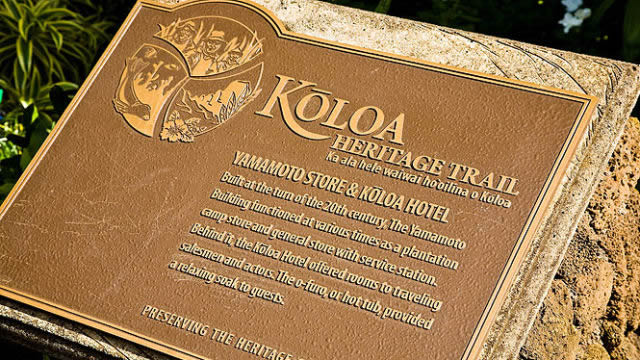Sunny Poipu Resort is Rich in History and Culture. When most people think of Poipu they think of the white sand beaches and sparkling blue water as well as the posh oceanfront resorts. Poipu also has numerous historical landmarks that take you on a journey back in time to the early days of Hawaii.
Many of Poipu’s important historical sites can be found along the Koloa Heritage Trail and are marked with plaques that provide information about the site. Here are some of Poipu’s most notable historic landmarks.
Planning a trip to the south side of Kauai? Check out our Poipu condos.
Spouting Horn Park – Known as Puhi (Blowhole) by ancient Hawaiians, Spouting Horn sends up huge plumes of water when the waves smash against the underwater lava shelf funneling a geyser skyward from the narrow hole in the rocks.
According to legend a huge mo’o (lizard) was caught in this blowhole and you can still hear the moaning sounds today. Spouting Horn is located along Lawai Road just south of the traffic circle
Prince Kuhio Park – On Lawai Road in Poipu is a park dedicated to Prince Jonah Kuhio Kalanianaole, the last heir to the Hawaiian throne. Prince Kuhio was born in this area in a grass hut. He later served as a Delegate to the United States Congress for 19 years.
Located within the park is the foundation of the home where Prince Kuhio lived. There is also an ancient Hawaiian fishpond, and to the rear of the park is Hoai Heiau. Prince Kuhio’s birthday on March 26 is a Hawaii state holiday and celebrated with events throughout the Islands. The park is south of the traffic circle on Poipu Road.
For more places to stay in Poipu, take a look at our Poipu luxury rentals.
Kihahouna Heiau – This ancient temple once had walls enclosing an area 130 feet long and 90 feet wide with an altar and oracle towers inside. The 16th century heiau (sacred place of worship) was dedicated to the Hawaiian god Kane as well as shark and bird gods. A plaque marking the site can be seen along Poipu Road east of the traffic circle, on the beach walk access at the Marriott Waiohai Beach Resort.
Makawehi and Pa’a Dunes – On the eastern end of the sand dunes of Makawehi are fossilized bird bones, plant roots, crab claws and more. Hawaiian seabirds and waterbirds nest and roost in this area, primarily from March to November. Makawehi means “Calm face” and Pa’a means “Hard rock.” A plaque is located on Ainako Street south of Poipu Road along the beach walk near the Grand Hyatt Kauai Resort.
Keoneloa Bay – Remnants of ancient Hawaiian culture in this area, including a fishing camp, have been discovered by archaeologists who dated the activity to around 200 to 600 A.D.
Also in this area were heiau (places of worship) including altars to the fishing god Kanaaukai. A plaque marking the site is located along Pe’e Road south of Poipu Road at the north end of the The Point at Poipu Resort parking lot.
The historic marker at Keoneloa Bay is the first of many along the Koloa Heritage Trail. From here you will be linked to a list of all of the Koloa Heritage Trail historical markers in the Poipu and Koloa areas.

